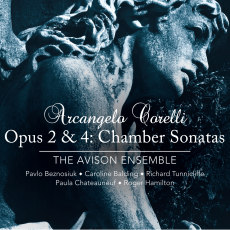The Avison Ensemble - Corelli: Opus 2 & 4: Chamber Sonatas - Audio Video Club of Atlanta
This is the third of four projected releases by Beznosiuk and the Avison ensemble on the 300th anniversary of the death of Arcangelo Corelli (1653-1713). The selections for the tribute were easy to determine because Corelli, the most perfectionist of composers, only published six opuses in his lifetime, and there has been absolutely no spate of spurious claims or rediscoveries in the centuries afterwards. What Corelli had to say in music, he said concisely and for all time. In fact, he was recognized as a 'classic' in his own time, and his reputation since then has not suffered the usual periods of neglect that plague almost every other composer.
The present release represents Corelli's chamber sonata (sonata da camera) style, Opus numbers 2 and 4. As distinct from the church sonata (sonata da chiesa), the chamber sonata incorporated frequent dance-inspired movements that would have been thought inappropriate for a sacred setting. That is not to say that there are no vestiges of Corelli's chiesa style in the 12 sonatas found in this program, particularly in the glorious solemnity of the opening movements, usually a Preludio marked 'Adagio' or 'Lento'. Even when the opening is an Allemanda, normally an energetic dance of German origin (as the name indicates), it is slow and stately.
Corelli's chamber sonatas are 'trio Sonatas,' typically performed by two violins in in the upper parts plus a cello or bass viol and a chordal instrument, usually a harpsichord, organ, or lute, for the purpose of realizing the underlying bass. They are in the pattern of a Preludio, followed by a short suite of two or three dances: Corrente, Gavotta, Sarabanda, Allemanda, or Giga, in various combinations. When the Allemanda is found in the second or a subsequent position, it is much faster than when it functions as a prelude. Even more strikingly, the Sarabanda, normally a slow, often sensual, dance, is often played at a quicker tempo, especially in the Opus 4 set, where Corelli allows himself more freedom in the way he constructs his sonatas. Consequently, his audiences were kept alert, not knowing what to expect next.
The upshot of all this is that Corelli's chamber sonatas are far from cookie-cutter designs, and they require the sort of rhythmically incise attention, with added care as to tempi and style, that the Avison Ensemble give them in these recordings. The performers are Pavlo Beznosiuk and Caroline Balding, violinists; Richard Tunnicliffe, cello; Paula Chateauneuf, archlute; and Roger Hamilton, harpsichord and organ. The interaction among these musicians is simply breathtaking at times, as in the Allemanda of Opus 2, No. 3 in which the first violin and bass parts descend together in parallel fifths (a type of movement that the bluestockings of Corelli's day considered lascivious. How times have changed!)

